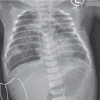Air Leak Syndrome: Pneumoperitoneum in a Ventilated Neonate
- PMID: 31956461
- PMCID: PMC6949679
- DOI: 10.1155/2019/4238601
Air Leak Syndrome: Pneumoperitoneum in a Ventilated Neonate
Abstract
Air leak syndrome has several manifestations and is common in neonates with meconium aspiration syndrome (MAS) due to air trapping. While pneumoperitoneum is classically a result of intestinal perforation, intra-abdominal free air may be a less common presentation of air leak syndrome. In the ventilated neonate, there is insufficient clinical evidence outlining management of pneumoperitoneum in this situation. We report a case of a term neonate with MAS and air leak syndrome who developed benign pneumoperitoneum (BPPT).
Copyright © 2019 Chandana Ravikumar et al.
Conflict of interest statement
The authors declare that they have no conflicts of interest.
Figures



References
-
- Hafis Ibrahim C. P., Ganesan K., Mann G., Shaw N. J. Causes and management of pulmonary air leak in newborns. Paediatrics and Child Health. 2009;19(4):165–170. doi: 10.1016/j.paed.2008.12.006. - DOI
Publication types
LinkOut - more resources
Full Text Sources

